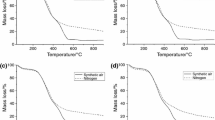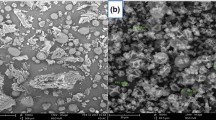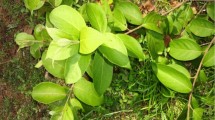Abstract
The aim of this study was to determine the physicochemical characteristics of leaves of Syzygium cumini L. Skeels plant and characterize the extract of this plant by analytical techniques. Pharmacopeial methods of physicochemical analysis were used, including morphological characterization of the particle, thermal analysis, infrared spectroscopy and X-ray diffraction. The plant drug was presented as a coarse powder, within the appropriate Brazilian Pharmacopoeia parameters. The X-ray diffraction, optical microscopy and scanning electron microscopy suggested that the extract particles are amorphous and have irregular shapes, so that clusters of different sizes and morphologies are displayed. Thermal decomposition of the organic components in the sample started in a step that occurred between 151.64 and 209.27 °C with mass loss of 9.08 %, followed by another step with more significant mass loss (28.16 %). The infrared spectrum, in turn, showed many functional groups of compounds present in the lyophilized extract in different absorption bands. The results showed that the analytical techniques allowed us to characterize the physicochemical properties of the plant leaves, which may be useful in the production of new herbal medicines.
Similar content being viewed by others
Explore related subjects
Discover the latest articles, news and stories from top researchers in related subjects.Avoid common mistakes on your manuscript.
Introduction
It is know that the Brazilian Cerrado corresponds to more than 2 million km2 of Central Brazil and is, by far, one of the major biomes, with rich overall biodiversity [1–3] harboring about 6500 plant species which about 220 species have been referred like natural remedy by its medicinal properties [3, 4]. Because of the vast biological diversity of that biome, which is home to 25 % of the world flora, different species of plants have been used as prototypes for the development of pharmaceuticals, pharmaceutical raw materials and herbal medicines. In this context, the use of products of natural origin is shown to be an interesting therapeutic alternative, since industrialized drugs may induce different adverse reactions. Furthermore, the plants can function as a therapy choice compared to synthetic antibiotics, which are extremely expensive and often designed to favor the mechanisms of resistance of microorganisms against the action of these drugs [5–7]. However, the production of a herbal product with quality and safety is slow, laborious and involves different steps including the identification of the plant, application of pharmacological models for the analysis of extracts, identification of the active ingredient and finally the clinical application of the herbal medicine [7, 8].
Studies about Syzygium cumini (L.) Skeels of the Myrtaceae species, popularly known as jambolan, suggest that their leaves especially rich in tannins and saponins are responsible for many therapeutic properties including anti-inflammatory, antimicrobial and antioxidant activity [9–14]. In folk medicine, S. cumini is one of the most commonly medicinal plants used for the treatment of insulin-dependent diabetes mellitus because of its hypoglycemic property [15]. However, extracts of different parts of Jambolan such as fruits, seeds and stem bark have been used for several pharmacological actions [15]. A native plant of the tropics, its more than 1100 species are irregularly distributed in regions of Africa, Asia, Australia and America, being cultivated in some countries, including Brazil, especially in the southeast, north and northeast regions [16], which favors the supply of raw material and thus aids in the base of scientific information about their properties.
Considering the need for alternative herbal medicines as safe and effective therapy against different existing conditions, it is essential to closely monitor the different stages of characterization of new raw materials from medicinal plants. Thus, the aim of this study was to determine the physicochemical characteristics of the lyophilized extract of S. cumini (L.) Skeel, which are of interest to the technological development of herbal medicines.
Materials and methods
Materials
In this study, leaves of the S. cumini (L.) Skeels (Myrtaceae), collected in a semiarid region in the state of Paraíba, Brazil, were used. A voucher specimen was deposited in the Arruda Câmara herbarium at the State University of Paraíba, Paraíba, Brazil (voucher # 084). The plant material was dried/dehydrated in a drying oven with air circulation (330/5, FANEM, São Paulo, SP, Brazil) at 45 °C until the final mass stabilization. The leaves were processed in a 10 mesh Wiley mill (Solab Equipamentos para Laboratórios Ltda., Piracicaba, SP, Brazil) to obtain a standard particle size. The hydroalcoholic extract was obtained by percolation during 5 days. For this, 100 g of plant material in 1000 mL of 70 % ethanol solution was used. The extract was then subjected to a lyophilization process (LS 3000 Terroni®; Terroni Equipamentos Científicos Indústria e Comércio Ltda, São Carlos, SP, Brazil) from 20 to 40 °C.
To predict the performance of the lyophilization process, the dry residue was determined. Two mL of liquid extract was transferred to Petri dishes, which were evaporated in a water bath. The residues were placed in a heater (03/32 Quimis®-7M; Diadema, SP, Brazil) at 105 °C during 4 h, cooled in a desiccator and weighed. This analysis was performed in triplicate and the solids calculated as a percentage. The ratio of the mass of waste deposited in the crucible and the initial mass of extract corresponded to a rate of 2 mL.
Morphological characterization of particles
The morphological characterization was performed by means of techniques of optical and scanning electron microscopy (SEM) [17–19]. Firstly, samples were visualized on KH-7700 Digital Microscope System (Hirox-USA, Inc., Hackensack, NJ, USA) in increments of 140, 280, 420, 560 and 1400×. For visualization of the extract particles by SEM, a Hitachi® TM 1000 microscope (Hitachi High Technologies, Krefeld, Germany) in increments of 100, 500, 1000, 2000, 3000, 5000 and 10000× was used.
Thermal analysis
Differential scanning calorimetry (DSC) was obtained from a Q20 DSC (TA Instruments, New Castle, DE, USA) using 2.0 ± 0.1 mg of sample mass packed in hermetically sealed pans with holes in the lid. It was analyzed in a nitrogen atmosphere (50 mL min−1), from 25 to 400 °C with a heating rate of 10 °C min−1. The curves were plotted using the Universal Analysis 2000 software [19].
The thermogravimetric curves were obtained in a SDT Q600 simultaneous analyzer (TA Instruments, New Castle, DE, USA), also in nitrogen atmosphere (50 mL min−1), from 25 to 900 °C with a heating rate of 10 °C min−1. The sample mass used was 8.0 ± 0.1 mg. The curves were then plotted using the Universal Analysis 2000 software.
Fourier transform infrared spectroscopy (FTIR)
The FTIR analysis was performed using a 1600 PerkinElmer® spectrophotometer (PerkinElmer do Brasil Ltda, São Paulo, SP, Brazil) with KBr disks in the range 4000–400 cm−1. Subsequently, the curves were plotted using the PerkinElmer UV WinLab software [19]
X-ray diffraction
The XRD-600 diffractometer (Shimadzu Scientific Instruments, Columbia, MD, USA) was used with a (2θ) 2°–70° scanning angle, with a rate of 2° min−1 and the Cu (Kα1) system. The equipment was operated in voltage of 40.00 kV and a current of 30 mA. Data were analyzed using the Origin® 8.0 version software [20].
Results and discussion
The optical microscopy images showed amorphous particles of the lyophilized extract of S. cumini leaves, with no standardization in its dimensions, and presenting various sizes and shapes (Fig. 1a, b). In SEM, the particles had irregular shapes, showing up as clusters of particles of different sizes and morphology, which confirms the results of the optical microscopy (Fig. 1c, d). It is known, however, that a dry extract should provide uniform particle size in order to promote a smooth flow of powder and good density [21].
Optical and scanning electron microscopy (SEM) of S. cumini showing amorphous particles, with no standardization in its dimensions, sizes and shapes: 1a optical microscopy (magnification ×280); 1b optical microscopy (magnification ×1400); 1c SEM (magnification ×500); and 1d SEM (magnification ×2000)
The S. cumini extract, however, showed a tendency to form agglomerates, this being a factor which indicates a poor property of powder flow, and probably influence their density and hygroscopicity characteristics. For the incorporation of the S. cumini extract in pharmaceutical dosage forms, it will be indispensable to use appropriate adjuvants to improve these technological features. Another study performed with the dry extract showed the interference of flow properties related to the high concentration of pharmaceutical excipient used in the drying process. It was observed that the Rhamnus purshiana (Cascara sagrada) dry extract obtained by spray-drying showed a low hygroscopicity and good flow properties [22], indicating that the selection of drying method and the addition of pharmaceutical adjuvants are essential for improving the flow properties of extracts.
In the DSC curve (Fig. 2), between the temperatures of 59.46 and 80.78 °C, it can be considered that there was an endothermic event (14.79 Jg−1). This event has been attributed to the loss of certain volatile products of the sample, such as residual solvent. In the temperature range between 114.82 and 150.69 °C, there was the largest endothermic peak of the DSC, with power from 61.76 J g−1. The Schinopsis brasiliensis and Ximenia americana dried extracts were evaluated [23] regarding the thermal behavior by DSC. It was noticed that the temperature range in which the first and most important DSC events occurred in the current study was similar to the study by Fernandes et al. [23], and between 39.17 and 126.14 °C. This phenomenon is probably related to the nature of the type of studied extract, or dry extract. In the temperature range between 213.10 and 285.03 °C, there was a subtle endothermic event.
Five events of thermal decomposition were observed by thermogravimetry (Fig. 2), where there was a larger mass loss that began at 59.07 °C and ended at 114.77 °C, revealing a change of 3.28 % in the mass of the material. In the range of 114.77–151.64 °C, the mass loss was slightly higher, 3.58 %.
The decomposition of the organic components in the sample started in a step that occurred between 151.64 and 209.27 °C, with a mass loss of 9.08 %, followed by another step whose mass loss was significantly higher (28.16 %). A study with the lyophilized extract of the Heliotropium indicum L. showed that the decomposition commenced at the temperature of 155.00 °C and the mass loss was 24.00 % [24], which was similar enough to the current study, probably a characteristic feature of this type of drying in plant extracts. It was still possible to verify a step of decomposition in temperatures between 385.15 and 692.37 °C, with mass loss of 19.89 %. The steps of thermal degradation occurring at different temperatures are due to the fact that samples of vegetable drugs are multicomponent mixtures of organic and inorganic compounds, and their thermal decomposition curves are involved in the physical and chemical phenomena that occur when they are heated. Furthermore, there is an influence of the shape and imperfections of the particles and loss of gaseous products [23–25]. At the end of the thermogravimetric (TG) curve, a residue of 30.02 % was obtained. It was not possible to determine the ash content of the sample since at the end of the strip for analysis, the sample had not completed all of its degradation processes.
According to the diffractogram (Fig. 3), the extract showed a high degree of amorphization between the angles of 20 and 30º, with no peaks of crystallinity. The presence of noise of different intensities can be explained by the fact that the extract consists of a complex array of unidentified substances, which hinders the formation of crystalline arrangements during the drying process. This effect can also be observed in the study of S. brasiliensis Engl. Dry extract with angles between 10° and 30° [23].
In the FTIR, the spectrum in the infrared (IR) region for the S. cumini leaf extract showed strong absorptions in the region of 3357 cm−1, characteristic of O–H axial stretch, as shown in Fig. 4. Absorption bands in the region of 2931 cm−1 were visible, typical of CH stretching vibration (alkane), being attributed to the nature of organic compounds in the extract. The presence of sp3 carbon in methyl-type grouping is shown in the bands of 1363 and 1450 cm−1. The mean intensity peaks observed in the 1041 and 1232 cm−1 region are characteristic related to carbon–oxygen bonds (CO), characteristic of functional groups, such as ether, ester and carboxylic acids, which are indicative of a variety of metabolites, such as tannins, flavonoids, anthraquinones, among others [23]. This effect is also shown in an absorption band of medium intensity at 1703 cm−1, characteristic of the carbonyl group. The absorption band at 1618 cm−1 is indicative of the C=C double bond, and the absorption at 604 cm−1 suggests the presence of aromatic CH [23]. In a similar study [26] to the present, the comparison of two spectra of S. cumini leaf extracts for spectroscopic characterization in the IR region showed similar absorption bands, confirming the presence of functional groups found in the present investigation.
Conclusions
The analytical techniques employed in this study were able to characterize the S. cumini L. Skeel medicinal plant, because it was possible to observe different sizes typical of amorphous particles of plant extracts. Different sizes of amorphous particles typical of plant extracts were observed. Still, the thermal profile and the spectroscopic in the region of the IV tracings for the plant material were relevant to the characterization of S. cumini. Future studies, including the pharmacological action of S. cumini can further elucidate the use of this raw material in the production of herbal medicines.
References
Silva JMC, Bates JM. Biogeographic patterns and conservation in the South American Cerrado: a tropical savanna hotspot. Bioscience. 2002;52:225–33.
Ratter JA, Ribeiro JF, Bridgewater S. The Brazilian cerrado vegetation and threats to its biodiversity. Ann Bot. 1997;80:223–30.
Rezende WP, Borges LL, Alves NM, Ferri PH, Paula JR. Chemical variability in the essential oils from leaves of Syzygium jambos. Rev Bras Farmacogn. 2013;23:433–40.
BRASIL. Ministério do MeioAmbiente (MMA). O BiomaCerrado. Brasília, 2009. http://www.mma.gov.br/biomas/cerrado.
Cartaxo SL, Souza MMA, Albuquerque UP. Medicinal plants with bioprospecting potential used in semi-arid northeastern Brazil. J Ethnopharmacol. 2010;131:326–42.
Pinn G. Herbal medicine in infectious disease. Aust Fam Physician. 2001;30:681–4.
Silva MSP, Brandão DO, Chaves TP, Formiga Filho ALN, Costa EMMB, Santos VL, Medeiros ACD. Study bioprospecting of medicinal plant extracts of the semiarid northeast: contribution to the control of oral microorganisms. Evid-Based Complement Altern. 2012;. doi:10.1155/2012/681207.
Malone MH. The pharmacological evaluation of natural products: general and specific approaches to screening ethnopharmaceuticals. J Ethnopharmacol. 1983;8:127–47.
Teixeira CC, Fuchs FD. The efficacy of herbal medicines in clinical models: the case of Jambolan. J Ethnopharmacol. 2006;108:16–9.
Mohamed AA, Ali SI, El-Baz FK. Antioxidant and antibacterial activities of crude extracts and essential oils of Syzygium cumini leaves. PLoS One. 2013;8:e60269.
De Bona KS, Bonfanti G, Bitencourt PE, Cargnelutti LO, da Silva PS, da Silva TP, Zanette RA, Pigatto AS, Moretto MB. Syzygium cumini is more effective in preventing the increase of erythrocytic ADA activity than phenolic compounds under hyperglycemic conditions in vitro. J Physiol Biochem. 2014;70:321–30.
Srivastava S, Chandra D. Pharmacological potentials of Syzygium cumini: a review. J Sci Food Agric. 2013;93:2084–93.
Siani AC, Souza MC, Henriques MG, Ramos MF. Anti-inflammatory activity of essential oils from Syzygium cumini and Psidium guajava. Pharm Biol. 2013;51:881–7.
Saxena S, Gautam S, Sharma A. Comparative evaluation of antimutagenicity of commonly consumed fruits and activity-guided identification of bioactive principles from the most potent fruit, Java plum (Syzygium cumini). J Agric Food Chem. 2013;61:10033–42.
Ayyanar M, Subash-Babu P, Ignacimuthu S. Syzygium cumini (L.) Skeels., a novel therapeutic agent for diabetes: folk medicinal and pharmacological evidences. Complement Ther Med. 2013;21:232–43.
Ayyanar M, Subash-Babu P. Syzygium cumini (L.) Skeels: a review of its phytochemical constituents and traditional uses. Asian Pac J Trop Biomed. 2012;2:240–6.
Bouhelier A. Field-enhanced scanning near-field optical microscopy. Microsc Res Tech. 2006;69:563–79.
Burton Z, Bhushan B. Surface characterization and adhesion and friction properties of hydrophobic leaf surfaces. Ultramicroscopy. 2006;106:709–19.
Yu H, Cheng L, Yin J, Yan S, Liu K, Zhang F, Xu B, Li L. Structure and physicochemical properties of starches in lotus (Nelumbo nucifera Gaertn) rhizome. Food Sci Nutr. 2013;1:273–83.
Kumar N, Singh P, Kumar S. Physical, X-ray diffraction and scanning electron microscopic studies of uroliths. Indian J Biochem Biophys. 2006;43:226–32.
Chaves JS, Da Costa FB, Freitas LAP. Development of enteric coated tablets from spray dried extract of feverfew (Tanacetum parthenium L.). Braz J Pharm Sci. 2009;45:573–84.
Gallo L, Llbot JM, Allemandi D, Bucalá V, Piña J. Influence of spray-drying operating conditions on Rhamnus purshiana (Cáscarasagrada) extract powder physical properties. Powder Technol. 2011;208:205–14.
Fernandes FHA, Santana CP, Santos LS, Correia LP, Conceição MM, Macêdo RU, Medeiros ACD. Characterization of dried extract of medicinal plant by DSC and analytical techniques. J Therm Anal Calorim. 2013;113:443–7.
Costa RS, Negrão CA, Camelo SR, Costa RM, Barbosa WL, Costa CE, Silva-Júnior JO. Investigation of thermal behavior of Heliotropium indicum L. lyophilized extract by TG and DSC. J Therm Anal Calorim. 2013;111:1959–64.
Wesolowski M, Konieczynski P. Thermoanalytical, chemical and principal component analysis of plant drugs. Int J Pharm. 2003;262:29–37.
Kumar V, Yadav SC, Yadav SK. Syzygium cumini leaf and seed extract mediated biosynthesis of silver nanoparticles and their characterization. J ChemTechnol Biotechnol. 2010;85:1301–9.
Author information
Authors and Affiliations
Corresponding author
Rights and permissions
About this article
Cite this article
Cartaxo-Furtado, N.A.O., de Castilho, A.R.F., Freires, I.A. et al. Physicochemical characterization of a new raw material obtained from leaves of Syzygium cumini (L.) Skeel (Myrtaceae). J Therm Anal Calorim 127, 1137–1141 (2017). https://doi.org/10.1007/s10973-016-5483-x
Received:
Accepted:
Published:
Issue Date:
DOI: https://doi.org/10.1007/s10973-016-5483-x








